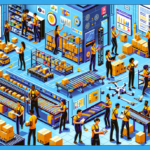Maximizing Efficiency with Extended Area Pickup
Efficient delivery systems are essential in today’s fast-paced business world. Companies constantly seek ways to get products and services into customers' hands swiftly and efficiently. One solution that has gained popularity in recent years is extended area pickup. This article explores what extended area pickup is, how it works, and the benefits it brings to businesses.
Understanding Extended Area Pickup
Extended area pickup is a delivery system that expands the geographic area in which businesses can offer pickup of goods for transport. With this system, customers can place orders and have them picked up by carriers—often within a broader geographical range. By using air transport, this process becomes more efficient and faster than traditional ground transport.
Extended area pickup requires coordination between multiple carriers, often via a digital platform, to ensure efficient transfer of goods and timely delivery to customers. This system allows businesses to reach customers in remote or hard-to-reach areas, which is particularly useful for businesses offering specialized or niche products not available in all areas.
Additionally, extended area pickup can help businesses reduce their shipping costs by consolidating multiple orders into one shipment, which is more cost-effective than shipping each order individually.
However, extended area pickup also presents challenges, such as coordinating multiple carriers and ensuring timely delivery, especially when dealing with unexpected delays or changes in delivery schedules. Businesses must also ensure proper packaging and labeling of products to avoid damage or loss during transport. Despite these challenges, extended area pickup can be a valuable tool for businesses looking to expand their reach and improve their shipping capabilities.
The Mechanics of Extended Area Pickup
- Order Placement: Customers place orders through the company's website or app.
- Carrier Coordination: Digital platforms coordinate with multiple carriers to pick up and transport goods.
- Air Transport Utilization: Leveraging air transport for faster delivery times.
- Consolidation of Shipments: Combining multiple orders into a single shipment to reduce costs.
Advantages of Extended Area Pickup for Businesses
The advantages of using extended area pickup for businesses are numerous:
- Expanded Customer Reach: Businesses can reach customers without establishing physical locations in every target area.
- Cost Efficiency: Consolidating deliveries reduces shipping costs, making it more economical.
- Environmental Impact: Reduced number of delivery vehicles lowers carbon footprint and traffic congestion.
- Improved Supply Chain Management: Centralized pickups and deliveries enhance inventory tracking and reduce stockouts.
Additionally, by providing a wider range of delivery options, businesses can improve customer satisfaction and expand their customer base.
Implementing Extended Area Pickup in Your Business
To implement extended area pickup effectively, businesses should:
- Define Clear Processes: Establish clear management procedures for deliveries, involving logistics teams, carriers, and customers.
- Establish Service Level Agreements (SLAs): Detail carrier responsibilities and performance metrics.
- Invest in Technology: Utilize a Transportation Management System (TMS) for managing increased delivery volumes and real-time tracking.
- Educate Customers: Provide clear information about the service, areas covered, delivery times, and any additional fees.
Implementing these strategies ensures smooth operations and maximizes the benefits of extended area pickup.
Cost-Effective Strategies for Maximizing Efficiency with Extended Area Pickup
Extended area pickup can be a cost-effective solution for businesses to expand their reach while keeping costs low. To maximize efficiency and cost-effectiveness, consider the following strategies:
- Use a Scalable Platform: Monitor carrier performance in real-time, manage multiple delivery nodes efficiently, and provide customers with insights about their order status.
- Optimize Routing: Ensure optimal routing and use of air transport to reduce costs and increase efficiency.
- Implement Dynamic Pricing: Adjust prices based on factors such as distance, time of day, and demand to incentivize customers to choose more cost-effective options.
- Partner with Other Companies: Share delivery networks and resources to reduce the number of underutilized vehicles and increase delivery speed.
Implementing these cost-effective strategies can significantly enhance the efficiency of extended area pickup services.
The Role of Technology in Streamlining Extended Area Pickup
Technology plays a pivotal role in streamlining extended area pickup processes. Key technological advancements include:
- Digital Platforms and Mobile Applications: Monitor shipments, manage multiple carriers, and provide real-time status updates to customers.
- Artificial Intelligence (AI) Systems: Optimize routing and ensure carriers use the most efficient modes of transportation, resulting in cost savings.
- Data Analytics: Businesses can track and analyze data related to extended area pickup to identify areas for improvement, optimize delivery routes, and adjust pickup times.
By leveraging these technologies, businesses can enhance the efficiency and effectiveness of their extended area pickup processes, making informed decisions based on comprehensive data analysis.
Best Practices for Managing Deliveries with Extended Area Pickup
Managing multiple delivery nodes and carriers requires careful coordination. Best practices include:
- Establish Service Level Agreements: Define carrier responsibilities and performance metrics to ensure consistent service quality.
- Real-Time Monitoring: Use digital platforms to monitor carrier performance, manage multiple carriers efficiently, and provide real-time updates to customers.
- Centralized Information Systems: Implement centralized systems that track all delivery-related data, including order details, carrier information, and delivery status.
- Customer Feedback Mechanisms: Use surveys or rating systems to gather feedback on delivery experiences, allowing businesses to identify areas for improvement.
By following these best practices, businesses can ensure smooth and efficient delivery operations, leading to enhanced customer satisfaction.
Case Studies: Real-Life Examples of Businesses Benefiting from Extended Area Pickup
Several businesses have successfully implemented extended area pickup, resulting in expanded customer reach and improved satisfaction:
- Amazon: Utilizes its air transport network to support its online retail business, improving delivery times and opening new markets without the need for additional physical locations.
- Local Bakeries: A local bakery partnered with a third-party delivery service to reach customers outside their immediate area, increasing sales and providing a more convenient service for existing customers.
- Healthcare Providers: Offer home delivery of medications and medical supplies, improving patient care for those unable to visit healthcare facilities, reducing missed appointments and hospital readmissions.
These examples demonstrate the tangible benefits of extended area pickup across different industries.
Overcoming Challenges in Implementing Extended Area Pickup
Businesses must address several challenges when implementing extended area pickup systems:
- Carrier Coordination: Establishing effective communication with carriers and monitoring their performance in real-time.
- Customer Preferences: Considering customers’ delivery preferences and times, and establishing backup plans for unforeseen circumstances like severe weather or carrier disruptions.
- Logistics Management: Optimizing routes, managing inventory, and ensuring timely pickups and deliveries using route optimization software and inventory management systems.
By addressing these challenges with robust strategies and technology solutions, businesses can successfully implement extended area pickup systems.
The Future of Delivery Services: How Extended Area Pickup is Changing the Game
As customer expectations for fast and efficient deliveries continue to evolve, businesses are driven to implement more innovative solutions. Extended area pickup is one such solution transforming the industry by:
- Expanding Geographic Reach: Allows for faster, more efficient delivery of products and services.
- Enhancing Customer Satisfaction: Provides customers with faster, more convenient delivery options.
- Reducing Carbon Footprint: Consolidates deliveries, reducing the number of delivery vehicles on the road, traffic congestion, and air pollution.
By embracing extended area pickup, businesses can not only stay competitive in a rapidly changing marketplace but also align with environmentally conscious practices favored by modern consumers.
Conclusion
Extended area pickup is a strategic solution for businesses seeking to expand their customer reach while maintaining low costs. By leveraging digital platforms that enable real-time performance monitoring and customer status updates, businesses can maximize efficiency and enhance customer service. With advancements in technology and carrier collaboration, extended area pickup is reshaping the delivery landscape, offering significant potential for growth and success in a dynamic business environment.






















